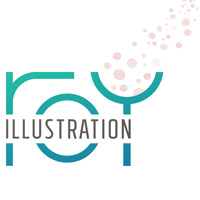What is an ellipse? It's how artists represent a circle in perspective, and it is…

Quick & Simple Cube Rendering in Photoshop
Why would you care to know how to render a basic cube in Photoshop? Because the steps involved are a simplification of the steps you can take to render anything more complex in Photoshop. Master these basic concepts, and you’ve mastered the first step to rendering anything in Photoshop.
The result of this tutorial will be a matte (not reflective) cube. The difference between this cube and a more complex matte object would be the amount of time spend adding and refining details such as reflected light or cast shadows (which we won’t cover here), as well as adding additional layers for color, reflections, etc.
But first, it’s important to establish an accurate drawing and value relationships.
- Sketch a cube in perspective, following the rules of 1, 2 or 3 pt. Place your sketch in your Photoshop document. If you wish to see your sketch throughout the process, place it as the top layer and set the Layer Blend Mode to “Multiply.”
- Create three paths to fit your cube as indicated below. They should overlap; you will understand why later.
Use P / pen tool to create paths, and the arrows to adjust them: A or shift+A will get you the black arrow (can move whole paths), and white arrow (moves individual points). Use the white arrow to adjust the anchor points of your paths to improve your drawing if you see errors in the original sketch.

Path 1 should cover the entire cube
Path 2 should cover one of the faces, overlapping another face and into the background (you’re only worried about one “clean” edge here”)
Path 3 should cover one face, (with two “clean edges” and otherwise overlapping into the background)
- Create your first fill by following these steps:
- Make a new layer
- Double-click on the Foreground Color palette and choose a light grey
- Select Path 1 using the black arrow
- Click the solid circle at the bottom of the Paths window (“Fill path with foreground color”).

- Create your second fill as follows:
- Make a new layer
- Right click on the new layer name and select “Create Clipping Mask”. This will “clip” it to the layer below, so only the pixels intersecting with that layer will be visible.
- Select Path 2 using the black arrow
- Click the solid circle at the bottom of the Paths window (“Fill path with foreground color”). At first it won’t look like anything happened, because you filled it with the same color and it is clipped to the previous layer.
- Use “Levels” to adjust the value: use hotkey (Ctrl+L on Windows or Cmd+L on Mac). Drag the output levels arrows to adjust the layer values.

- Create your third fill by repeating step 3 with your 3rd path.

- Finish Up
- In your “Paths” window, click in the empty space to deselect your paths. Also, hide your sketch layer. Then you can see your cube more easily.
- Make any value adjustments to the fill layers using the levels techniques for a clear lighting scheme.
- When you are satisfied, merge your three layers (NOT YOUR SKETCH LAYER): hold the shift key and click each of the three layers. Then right click on one and select “Merge Layers”. LOCK the layer.

- In your Paths window, click your Work Path, then delete it using the trash can at the lower right.
NOTE: for more complex illustrations, or if you would anticipate needing to use the paths again for any reason, you would not delete them. Instead you would rename your Work Path (i.e. “cube 1”) and make a new “Path Layer” for different objects. - Save your work!
There you have it! A simple matte cube. To take this further, you could add a little reflected light and a cast shadow. Color and more will be discussed in future tutorials.
KEY TAKEAWAYS: Use overlapping paths to refine your drawing and create a clean base layer. Use a new path for every overlapping shape or location you will need a sharp edge.
Did you find this helpful? Do you have any of your own tips you’d like to share? I’d love to hear about it if you decide to try something new. If you use it differently, I’d love to hear that, too!

– Laura




This Post Has 0 Comments